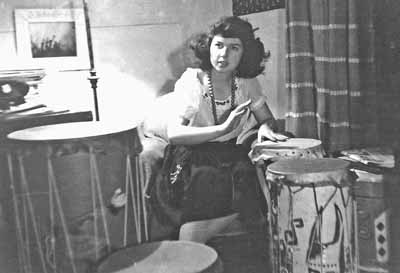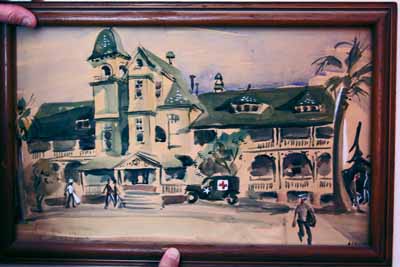|

Bob says of this photo of his girlfriend, Robin: "I was on Okinawa, photo enclosed showed a soldier's hat on her table.... she later explained it was a friend, Staff Sergeant xxxxx, a lousy thing to get in your mail! Sept, 1945...could change your plans."

Marian, Uncle Bob (who was responsible for tranferring his nephew, Bob, from the Army to the Naval C.B.s), Aunt Ted
 Robin painted this watercolor of the VA hospital near where Bob lived Robin painted this watercolor of the VA hospital near where Bob lived
|
Bob started the year at Port Hueneme. The Naval troop carrier (the first in its class), the USS Gilliam embarked men of the 6th Seabee Battalion a Port Hueneme, California, and sailed 28 May 1945 for Okinawa via Eniwetok and Ulithi. She off-loaded cargo and passengers at Okinawa and then headed back to San Francisco.
Bob remembered in 2015:
As I boarded the Gilliam, my work then was assignment to a Land Surveying Party.
A more detailed explanation of landing on Okinawa could be found in his blogs made Oct.2010:
Call me a liar, Joe those are fighting words. I ain’t a 90 year old draftee for
nothing. I helped draw the plans for your dad’s Iwo landing, transcribing the
field notes of our naval pre-landing scuba-diver spies mapping Iwo’s beaches off
subs. Our ship was under fire when we clambered down those rope nets into those
bouncing boats at night. That morning I had the experience of seeing a boot,
floating in the surf. When I retrieved it, I found a foot still inside the boot.
That made me thankful that I never got a scratch!
An earlier blog:
In June 1945, when we landed on Okinawa, Our first CB campsite was in a rice
field was near a cliff that had a series of cave-tombs dug into the limestone.
Some of these tombs had been used by the resisting Japanese troops as sniper
posts and had been burned out. We learned that the tombs (with wood doors that
we broke into, not only because of our curiosity, but to assure ourselves that
the tombs were not a threat to our camp) were fitted with shelves, and on the
shelves were boxes of bones, and we realized that these were the ancient tombs
of the “Lu Chu” families that had forever farmed the rice fields. We were later
told that the custom was for the natives to reverently keep these bones clean,
and to make token offerings of food to their ancestors regularly.
The things
that most interested us grave-robbers were the small ceramic china vessels, in
which these food offerings were placed, alongside of those bones. These small
keep-sakes were durable, beautiful and portable. Perhaps we are damned for
having these on our USA knick-knack shelves.
Also, while on Okinawa, Bob remembers:
Our officer in charge of the pile driving barge in a bay on the island of Okinawa had some experience running a crew that set a line of telephone poles across the island. We were driving wood pilings to get a docking pier extended into the bay and the steel points on the piles were not penetrating the coral ground in the deeper water and a number of wood poles were breaking under the force of the 5-ton steam hammer.
So he got an inspiration to try a new method of penetrating the coral. His pole setting crew had used "shaped charges" to dig the telephone pole holes. These charges were a high explosive shaped like a dixie cup, a hollow cone. The cone was fixed to the bottom of the wood pole inside of a sheet-metal stool that supported the pole erected over the point chosen to set the pole. When the cup was detonated, half of the explosive force was focused downward under the pole spearing a 6-foot deep hole in the soil into which the guyed pole fell, saving the labor of using a post-hole digger.
Why not use it to set pilings deep into the coral? So a fresh piling was fixed with a shaped charge, detonator connected to the exploder, piling lowered to the coral underwater, 5-ton hammer atop the pile, ready to begin hammering after the explosion. He set it off, The wood pile broke in its middle. The 5-ton hammer drove itself and the splinters to the bottom of the bay, ripping the steam hose and the valve off the side of the steam boiler, and every member of the crew including the officer-in-charge dove into the calm warm water of Buckner Bay.We learned the next week that the dock was thought no longer needed because of the Atom Bomb at Hiroshima.
He also remembers:
On a small tropical island, bored troops wasted away on their cots in their pyamidal tents. I learned that our officer in charge of recreation had recieved a volleyball and a net. So I picked out a spot behind our row of tents, dug two postholes, found two 8-foot posts to set, and laid out a court, hoping to find someone to kill the ball with. While I was doing this several of my mates jeered at my efforts, but soon one joined me, then more. I thought I was going to enjoy my play, but soon we had dozens of competitors teaming up and I was relegated to be only a spectator, leaning on a shovel.
He also remembers:
Our 1945 Seabee encampment at Nagagasuku Bay intruded on the terraced farms close to the concentration camp of the thousands of displaced farm famllies. Their keepers often escorted small family groups on foraging expeditions through our camp. Bearded me, alone, encountering, and outnumbered by a foraging group, was startled by their reaction to my bearded presence...The 'Loo Choo' natives are all talented mimics, and each of that group, impressed with my beard, competed with each other to mime a fat strutting Santa Claus!
|

